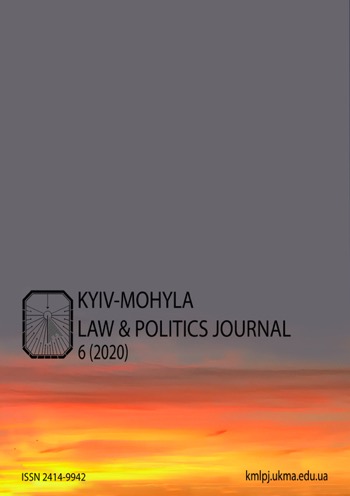Responding to Hybridity in an Unstable Neighborhood: The Efficiency of the EU State-centric Approach to the Crisis in Libya and Ukraine
DOI:
https://doi.org/10.18523/kmlpj220689.2020-6.1-25Keywords:
European Union, crisis response, hybridity, security sector reform, humanitarian assistance, stabilization.Abstract
This article investigates the complex problems arising from the discrepancy of traditional liberal crisis response approaches in the new type of complex emergencies. Based on the in-depth empirical analysis, it examines the EU role in addressing security sector reforms, humanitarian assistance and warfare in Libya and Ukraine, two key EU neighboring countries with ongoing military conflicts. It is argued that the observed over-emphasis on state-centric stabilization measures, with its main focus on formal state structures, fails to deal with the hybrid dynamics of conflict and peacebuilding in both countries. It is suggested that to shape comprehensive crisis response in an unstable neighborhood a multi-layered perspectives approach to security, sensitive to plural agencies and informal rules, should be developed both outside and within EU borders.
Supporting Agencies
- EU Commission Horizon 2020 Project EUNPACK — Good intentions
- mixed results. A conflict sensitive unpacking of the EU comprehensive approach to conflict and crisis mechanisms [H2020-INT‑05–2015]
- Grant Agreement n. 693337 http
- //www.eunpack.eu.
References
- Adler-Nissen, Rebecca and Pouliot Vincent. "Power in practice: Negotiating the international intervention in Libya." European Journal of International Relations 20, no. 4 (January 2014): 889–911.
- Albrecht, Peter and Wiuff Moe Lousie. “The Simultaneity of Authority in Hybrid Orders.” Peacebuilding 3, no. 1 (2015): 1–16.
- Bach, Daniel C. and Mamoudou Gazibo (eds.). Neopatrimonalism in Africa and Beyond. New York: Routledge, 2012.
- Bagayoko, Niagale and Eboe Hutchful, and Robin Luckham. “Hybrid Security Governance in Africa: Rethinking the Foundations of Security, Justice and Legitimate Public Authority.” Conflict, Security & Development 16, no. 1 (2016): 1–32.
- Belloni, Roberto. “Hybrid Peace Governance: Its Emergence and Significance.” Global Governance 18, no. 1 (2012): 21–38.
- Boege, Volker. “Potential and Limits of Traditional Approaches in Peacebuilding.” in Advancing Conflict Transformation. The Berghof Handbook II. eds. Beatrix Austin, Martina Fischer, and Hans J. Giessmann. (Opladen: Barbara Budrich Publishers, 2011): 433.
- Bojicic-Dzelilovic, Vesna and Denisa Kostovicova, and Elisa Randazzo. “EU in the Western Balkans: Hybrid Development, Hybrid Security and Hybrid Justice.” Security in Transitions Working Paper no. 03/16 (2016).
- Charlemagne. “Europe's Ring of Fire.” The Economist, (September 20, 2014).
- Clapham, Christopher. “The global-local politics of state decay,” in When states fail: causes and consequences. ed. Robert I. Rotberg. (Princeton, NJ: Princeton University Press, 2003).
- Cole, Peter, and Fiona Mangan. “Policing Libya. Form and Function of Policing since the 2011 Revolution.” Peacework, no. 117, (Washington: USIP. 2016).
- De Bruijne, Kars, El Kamouni-Janssen, Floor, and Molenaar, Fransje. “European security interests at stake in Libya?” Clingendael Crisis Alert Report. Den Haag (2017).
- Debiel, Tobias and Rinck Patricia. “Statebuilding,” in: Routledge Handbook of Security Studies, 2nd edition. eds. M. Dunn Cavelty and T. Balzacq. (London: Routledge, 2017).
- Donais, Timothy. “Engaging Non-State Security Providers: Whither the Rule of Law?” International Journal of Security & Development 6, no. 1 (2017).
- Eaton, Tim. “Libya’s War Economy: Predation, Profiteering, and State Weakness.” Chatham House Research Paper 4 (2018).
- EEAS. “EUBAM Libya Initial Mapping. Report Executive Summary.” (Brussels, Belgium: Council of the European Union, January 2017).
- European Commission. “Decision on the establishment of a European Union Emergency Trust Fund for stability and addressing root causes of irregular migration and displaced persons in Africa.” (Brussels, Belgium: October 20, 2015).
- European Commission. “Shared Vision, Common Action: A Stronger Europe. A Global Strategy for the European Union’s Foreign and Security Policy.” (Brussels, Belgium: June 2016).
- European Commission. “Migration on the Central Mediterranean route. Managing flows, saving lives.” (Brussels, Belgium: January 25, 2017).
- European Commission, High Representative of the Union for Foreign Affairs and Security Policy. “Review of the European Neighbourhood Policy.” (Brussels, Belgium: November 18, 2015).
- Galeotti, Mark. “Hybrid, Ambiguous, and Non-linear? How New is Russia’s ‘New Way of War’?” Small Wars & Insurgencies 27, no. 2 (2016): 282–301.
- Galeotti, Mark. “Crimintern: How the Kremlin Uses Russia's Criminal Networks in Europe.” ECFR Policy Brief (2017).
- Goldgeier, James and Michael McFaul. “The Liberal Core and the Realist Periphery in Europe.” Perspectives on European Politics and Society 2, no. 1 (2001): 1–26.
- Ivashchenko-Stadnik, Kateryna. “What’s wrong with the Donbas? The challenges of integration before, during, and after the war,” in Ukraine in Transformation: from Soviet Republic to European Society. eds. A. Veira Ramos and T. Lubiva. (London: Palgrave, 2020): 229–60.
- Ivashchenko-Stadnik, Kateryna, and Roman Petrov, Luca Raineri, Pernille Rieker, Alessandra Russo, and Francesco Strazzari. “How the EU is facing crises in its neighbourhood: evidence from Libya and Ukraine.” EUNPACK Working Paper D6.1. (2017).
- Ivashchenko-Stadnik, Kateryna, and Roman Petrov, Pernille Riekerand, Alessandra Russo. “The Implementation of the EU’s crisis response in Ukraine.” EUNPACK Working Paper D6.3. (2018).
- Ivashchenko-Stadnik, Kateryna, and Roman Petrov, Alessandra Russo. “A Summary of Perception Studies in Ukraine.” EUNPACK Policy Brief D6.4. (2017).
- Jayasundara-Smits, Shyamika. “From Revolution to Reform and Back: EU-Security Sector Reform in Ukraine.” WOSCAP article D4.14. (2016).
- Kaldor, Mary. Global Security Cultures. Cambridge, UK: Polity Press, 2018.
- Krause, Keith. “Hybrid Violence: Locating the Use of Force in Postconflict Settings.” Global Governance: A Review of Multilateralism and International Organizations 18, no. 1 (August 12, 2012): 39–56.
- Lacher, Wolfram. “Tripoli's militia cartel.” SWP Comment 20/2018. (Berlin: Stiftung Wissenschaft und Politik, 2018).
- Lawrence, Michael. “Security Provision and Political Formation in Hybrid Orders. Stability.” International Journal of Security and Development 6, no. 1 (2017): 10.
- Likhachev, Vyacheslav. “Far-right Extremism as a Threat to Ukrainian Democracy.” Nations in Transit Brief. (Washington, DC: Freedom House, Freedom House Nations in Transit Brief, 2018).
- Leonid Litra, Ivan Medynskyi, and Kateryna Zarembo. “Assessing the EU’s conflict prevention and peacebuilding interventions in Ukraine.” WOSCAP Case Study Report D3.4.(2016).
- Loschi, Chiara, and Luca Raineri. “Perceptions about the EU’s Crisis Response in Libya.” EUNPACK Policy Brief D6.4. (2017).
- Loschi, Chiara, and Luca Raineri, Francesco Strazzari. “The implementation of EU Crisis Response in Libya: Bridging theory and practice.” EUNPACK Working Paper D6.2. (2018).
- MacGinty, Roger. International Peacebuilding and Local Resistance: Hybrid Forms of Peace. Basingstoke: Palgrave Macmillan, 2011.
- Manners, Ian. “Normative Power Europe: A Contradiction in Terms?” Journal of Common Market Studies 40, no. 2 (2002): 235–58.
- Messner J. J. and Blyth Hannah. “Springtime for Castro and Cuba; Winter for Ukraine and Libya in Fragile States Index, The Fund for Peace.” (2015): 13. Accessed December 13, 2020. https://reliefweb.int/sites/reliefweb.int/files/resources/fragilestatesindex-2015.pdf.
- Messner J. J. (ed.). Fragile States Index, The Fund for Peace (2020): 6. Accessed December 13, 2020. https://fragilestatesindex.org/wp-content/uploads/2020/05/fsi2020-report.pdf.
- Nadarajah, Suthaharan and Rampton David. “The Limits of Hybridity and the Crisis of Liberal Peace.” Review of International Studies 41, no. 1 (2015): 49–72.
- Noack, Rick. “The European parties accused of being influenced by Russia.” Washington Post (November 17, 2017).
- Polese, Abel. “Limits of a Post-Soviet State: How Informality Replaces, Renegotiates, and Reshapes Governance in Contemporary Ukraine.” Stuttgart: Ibidem Verlag (2016).
- Polese, Abel, Kevilhan Rob, and Ó-Beacháin Donnacha. “Introduction: hybrid warfare in post-Soviet spaces, is there a logic behind?” Small Wars & Insurgencies 27, no. 3 (2016).
- Pomorska, Karolin, and Gergana Noutcheva. “Europe as a Regional Actor: Waning Influence in an Unstable and Authoritarian Neighbourhood.” Journal of Common Market Studies 55, no. 1 (2017): 165–76.
- Prodi, Romano. “A Wider Europe: A Proximity Policy as the Key to Stability,” in 6th ECSA World Conference Peace, Security and Stability International Dialogue and the Role of the EU. (Brussels: on 5–6 December 2002).
- Pusztai, Wolfgang. “The Haftar-Russia link and the Military Plan of the LNA.” ISPI Dossier 2 (2017).
- Richmond, Oliver and Mitchell Audra. Hybrid Forms of Peace: From Everyday Agency to Post-Liberalism. Basingstoke: Palgrave Macmillan (2012).
- Richmond, Oliver. “Failed Statebuilding versus Peace Formation.” Cooperation and Conflict 48, no. 3 (2013).
- Richmond, Oliver, and Sandra Pogodda, and Roger MacGinty. “Good intentions, mixed results – A conflict sensitive unpacking of the EU comprehensive approach to conflict and crisis mechanisms.” EUNPACK Working Paper D.3.2.(2016).
- Rieker, Pernille. External governance as security community building: the limits and potential of the European Neighbourhood Policy. (London, UK: Palgrave Macmillan, 2016).
- Roberts, David. Liberal peacebuilding and global governance: beyond the metropolis. (London: Routledge, 2011).
- Schnaufer, Tad. “Redefining Hybrid Warfare: Russia’s Non-linear War against the West.” Journal of Strategic Security 10, no. 1 (2017).
- Shaw, Mark and Mangan, F. “Enforcing ‘Our Law’ When the State Breaks Down: The Case of Protection Economies in Libya and Their Political Consequences.” Hague Journal on the Rule of Law 7, no. 1 (2015): 99–110.
- Stocker, Valerie. “Leaving Libya: Rapid Assessment of Municipalities of Departures of Migrants in Libya.” Tunis: Altai Consulting 92 (2017).
- Taft, Patricia. “Libya Continues Path as the Decade’s Most Worsened Country.” Fragile States Index, The Fund for Peace (2020): 27, 28. Accessed December 13, 2020. https://fragilestatesindex.org/2020/05/10/libya-continues-path-as-the-decades-most-worsened-country/.
- Tardy, Thierry. “Tackling the challenges of SSR.” EUISS Issue Alert 14 (2015).
- United Nations. Interim report of the Panel of Experts on Libya established pursuant to resolution 1973 (2011). New York: USA, 2017.
- United Nations. Report to the Security Council (unpublished) (2018).
Downloads
Published
How to Cite
Issue
Section
License
Copyright (c) 2020 Luca Raineri, Kateryna Ivashchenko-Stadnik, Roman Petrov

This work is licensed under a Creative Commons Attribution 4.0 International License.
Kyiv-Mohyla Law and Politics Journal provides free access to original research without restriction barriers (i.e. subscription fees, licensing fees etc.).
Unless otherwise indicated, content is licensed under the Creative Commons Attribution 4.0 International (CC BY 4.0) license, which means you are free to:
distribute, remix, tweak, and build upon your work, even commercially
...provided that any use is made with attribution to author(s) and Kyiv-Mohyla Law and Politics Journal.
The copyright in the article or any other submission to Kyiv-Mohyla Law and Politics Journal shall remain with the author(s).
The journal allows the author(s) to hold the copyright without restrictions and will retain publishing rights without restrictions.





